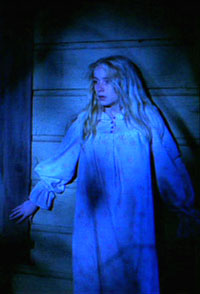 Under its sundry alternative titles this film is never complete, & not all copies in circulation under the preferred title Lemora: A Child's Tale of the Supernatural (1973) are quite complete either, generally under 90 minutes. The uncut version should weigh in at 113 minutes & be uncropped anamorphic widescreen.
Under its sundry alternative titles this film is never complete, & not all copies in circulation under the preferred title Lemora: A Child's Tale of the Supernatural (1973) are quite complete either, generally under 90 minutes. The uncut version should weigh in at 113 minutes & be uncropped anamorphic widescreen.
The first complete uncensored version on dvd includes a commentary track by the director & the actress who played the title character. Its restoration was overseen by the director, Richard Blackburn, who seems never to have made another film.
A notorious film in its day, the Catholic Film Board had it on their list of condemned movies for two decades. Today it seems not so daring but is nevertheless a powerful low-budget film with the intimations of the preacher having molested the child Lila, & the lesbianism between Lemora (Leslie Gilb) & Lila is discomfiting to say the least, since Lila is only thirteen years old. She's played by an unnervingly angelic-but-sexy seventeen year old.
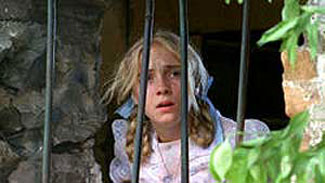 Cheryl Smith (1957-2002) became known as Rainbeaux Smith, for having been a habitue of such infamous clubs as the Whiskey A-Go-Go & the Rainbow Bar. Cheryl Smith (1957-2002) became known as Rainbeaux Smith, for having been a habitue of such infamous clubs as the Whiskey A-Go-Go & the Rainbow Bar.
She did sexploitation films, being immortalized as a B-film cult figure. Drug abuse resulted in hepatitis infection & ill health & a couple prison terms, ultimately an early death.
She appeared in her first movie at age fifteen, the action biopic Evel Knievel (1971), a role too small to include in the cast credits. Lemora was her third film, & with her impassively angelic face, belying her Sunset Strip street wisdom, her underage sensuality was alone enough to be disturbing in this role.
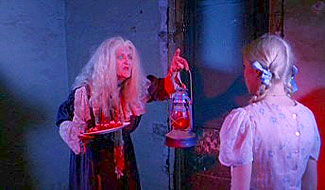 Set in a timeless version of the 1920s or 30s, a gangster bank robber & killer (William Whitton) drives his on-the-lam-mobile to an isolated village called Asteroth, inhabited by the deteriorating undead. Set in a timeless version of the 1920s or 30s, a gangster bank robber & killer (William Whitton) drives his on-the-lam-mobile to an isolated village called Asteroth, inhabited by the deteriorating undead.
He becomes the captive of the queen vampire Lemora, who uses him as bait to get his pure-hearted daughter Lila to come to the strange town ostensively so that her father can apologize to her on his deathbed for never having been a proper dad.
Lila journeys in an antique motor bus down dirt roads to the village of the ghouls. The trip is wondrously creepy. The bus driver (Hy Pyke) is played by a rarely seen character actor of great cool ability to be totally wacked out & strange. The commentary track, richer with more interesting details than most commentary tracks, tells a couple very strange stories about this actor.
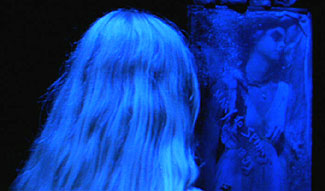 A key premise is not clearly stated in the script & it can be disorienting trying to figure out why there seem to be two kinds of vampires. But repeat viewing reveals that vampirism takes two forms depending on the inherent nature of the infected individual. A key premise is not clearly stated in the script & it can be disorienting trying to figure out why there seem to be two kinds of vampires. But repeat viewing reveals that vampirism takes two forms depending on the inherent nature of the infected individual.
Those who were in some manner noble become immortal, classic vampires -- not "good" vampires because they're soulless, but better than those who were villainous & cruel before ever being bitten. Those who always had dark hearts become ghoulish monstrosities & shamble about mindlessly seeking victims.
Or such is Lemora's own understanding of what is happening to her kind. She is herself quite beautiful, but worries that eventually she too will become like the ghoulish others who inhabit the village below her mansion, & have become increasingly troublesome. She & the "better" vampires hunt & burn the ghouls, which remain far more numerous.
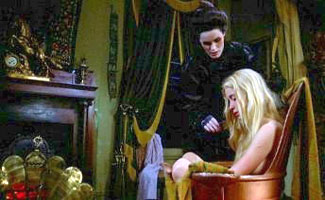 It's Lemora's belief that she must find as her own companion a girl of such extreme purity & goodness that the infection of vampirism can never entirely rot her soul. It's Lemora's belief that she must find as her own companion a girl of such extreme purity & goodness that the infection of vampirism can never entirely rot her soul.
Lila, a well known gospel singing child all but worshipped by rural Christians, has been in the newspapers as the saintly daughter of a villainous criminal, fostered by a young priest (played by the director).
Lemora does not seem totally convinced of her own theory & may be acting with an edge of desperation, or just out of perversion, as she fairly clearly has the hots for young girls.
A bathing sequence with Lemora commenting lasciviously on Lila's nubile body is more sinister than the vampirism itself, the more disturbing because both actresses are in fact pretty sexy.
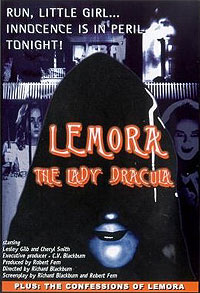 An unfortunately underdeveloped thread of the story regards a previous young girl kidnapped by Lemora for transformation. An unfortunately underdeveloped thread of the story regards a previous young girl kidnapped by Lemora for transformation.
The remains of this failed experiment, merely hinted at in the script, are encountered by Lila in quite a creepy sequence, but the full impact of the discovery is weakened by inedequately conveying what the beautiful corpse, seemingy imbedded in ice, is all about.
Even on repeat viewing I have no clue why she's in ice, or if it's supposed to be a smudgy glass-lid coffin. Whatever it is, the image is my favorite in the film & I only wish it fit the story more clearly.
Lemora is a surprising blend of arthouse cinema & sleezy horror. That it has lapses of logic & some unnecessarily confusing bits keeps it from being a truly great film, but as a B horror it's a spectacular example.
That the director & co-writer were hard-core fans of classic horror fiction is doubtless the cause of the film's comparative intelligence, with admitted influences from H. P. Lovecraft's "Shadow Over Innsmouth," Arthur Machen's "The White People" & Mervyn Peake's "Boy in Darkness."
Continue to:
Zoltan, Hound of Dracula (1978)
copyright © by Paghat the Ratgirl
|
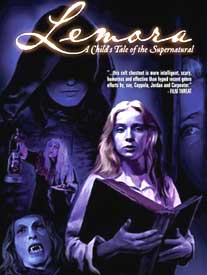

 Cheryl Smith (1957-2002) became known as Rainbeaux Smith, for having been a habitue of such infamous clubs as the Whiskey A-Go-Go & the Rainbow Bar.
Cheryl Smith (1957-2002) became known as Rainbeaux Smith, for having been a habitue of such infamous clubs as the Whiskey A-Go-Go & the Rainbow Bar. Set in a timeless version of the 1920s or 30s, a gangster bank robber & killer (William Whitton) drives his on-the-lam-mobile to an isolated village called Asteroth, inhabited by the deteriorating undead.
Set in a timeless version of the 1920s or 30s, a gangster bank robber & killer (William Whitton) drives his on-the-lam-mobile to an isolated village called Asteroth, inhabited by the deteriorating undead. A key premise is not clearly stated in the script & it can be disorienting trying to figure out why there seem to be two kinds of vampires. But repeat viewing reveals that vampirism takes two forms depending on the inherent nature of the infected individual.
A key premise is not clearly stated in the script & it can be disorienting trying to figure out why there seem to be two kinds of vampires. But repeat viewing reveals that vampirism takes two forms depending on the inherent nature of the infected individual. It's Lemora's belief that she must find as her own companion a girl of such extreme purity & goodness that the infection of vampirism can never entirely rot her soul.
It's Lemora's belief that she must find as her own companion a girl of such extreme purity & goodness that the infection of vampirism can never entirely rot her soul. An unfortunately underdeveloped thread of the story regards a previous young girl kidnapped by Lemora for transformation.
An unfortunately underdeveloped thread of the story regards a previous young girl kidnapped by Lemora for transformation.